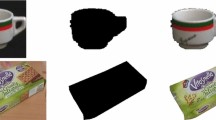Abstract
This paper presents a new approach to the problem of simultaneous location and segmentation of object in images. The main emphasis is done on the information provided by the contour fragments present in the image. Clusters of contour fragments are created in order to represent the labels defining the different parts of the object. An unordered probabilistic graph is used to model the objects, where a greedy approach (using dynamic programming) is used to fit the graph model to the labels.
Access this chapter
Tax calculation will be finalised at checkout
Purchases are for personal use only
Preview
Unable to display preview. Download preview PDF.
Similar content being viewed by others
References
Agarwal, S., Awan, A., Roth, D.: Learning to detect objects in images via a sparse, part-based representation. IEEE PAMI 26(11), 1475–1490 (2004)
Borgefors, G.: Hierarchical chamfer matching: a parametric edge matching algorithm. IEEE PAMI 10(6), 849–865 (1988)
Canny, J.F.: A computational approach to edge detection. IEEE Transactions on Pattern Analysis and Machine Intelligence 8(6), 679–698 (1986)
Crandall, D.J., Huttenlocher, D.P.: Weakly supervised learning of part-based spatial models for visual object recognition. In: Leonardis, A., Bischof, H., Pinz, A. (eds.) ECCV 2006. LNCS, vol. 3951, pp. 16–29. Springer, Heidelberg (2006)
Cremers, D., Kohlberger, T., Schnörr, C.: Nonlinear Shape Statistics in Mumford-Shah Based Segmentation. In: Heyden, A., Sparr, G., Nielsen, M., Johansen, P. (eds.) ECCV 2002. LNCS, vol. 2351, pp. 93–108. Springer, Heidelberg (2002)
Fergus, R., Perona, P., Zisserman, A.: Object class recognition by unsupervised scale-invariant learning. In: CVPR, vol. 2, pp. 264–271 (2003)
Fergus, R., Perona, P., Zisserman, A.: A sparse object category model for efficient learning and exhaustive recognition. In: CVPR, pp. 380–387 (2005)
Ferrari, V., Tuytelaars, T., Van Gool, L.: Object detection by contour segment networks. In: Leonardis, A., Bischof, H., Pinz, A. (eds.) ECCV 2006. LNCS, vol. 3953, pp. 14–28. Springer, Heidelberg (2006)
Fred, A.L.N., Leitao, J.M.N.: A new cluster isolation criterion based on dissimilarity increments. IEEE Trans. on PAMI 25(8), 1–15 (2003)
Leibe, B.: Interleaved Object Categorization and Segmentation. PhD thesis, ETH Zurich (October 2004)
Mokhtarian, F., Bober, M.: Curvature Scale Space Representation: Theory, Applications & MPEG-7 Standardisation. Springer, Heidelberg (2003)
Opelt, A., Pinz, A., Zisserman, A.: A boundary-fragment-model for object detection. In: Leonardis, A., Bischof, H., Pinz, A. (eds.) ECCV 2006. LNCS, vol. 3952, pp. 575–588. Springer, Heidelberg (2006)
Shotton, J., Winn, J.M., Rother, C., Criminisi, A.: TextonBoost: Joint appearance, shape and context modeling for multi-class object recognition and segmentation. In: Leonardis, A., Bischof, H., Pinz, A. (eds.) ECCV 2006. LNCS, vol. 3951, pp. 1–15. Springer, Heidelberg (2006)
Song, Y., Goncalves, L., Perona, P.: Unsupervised learning of human motion. IEEE Trans. Patt. Anal. and Mach. Intell. 25(7), 1–14 (2003)
Veltkamp, R.C.: Shape matching: Similarity measures and algorithms. In: Shape Modelling International, pp. 188–199 (2001)
Weber, M., Welling, M., Perona, P.: Unsupervised learning of models for recognition. In: Vernon, D. (ed.) ECCV 2000. LNCS, vol. 1842, pp. 18–32. Springer, Heidelberg (2000)
Author information
Authors and Affiliations
Editor information
Rights and permissions
Copyright information
© 2007 Springer Berlin Heidelberg
About this paper
Cite this paper
Marín-Jiménez, M.J., de la Blanca, N.P., Gómez, J.I. (2007). Locating and Segmenting 3D Deformable Objects by Using Clusters of Contour Fragments. In: Martí, J., Benedí, J.M., Mendonça, A.M., Serrat, J. (eds) Pattern Recognition and Image Analysis. IbPRIA 2007. Lecture Notes in Computer Science, vol 4477. Springer, Berlin, Heidelberg. https://doi.org/10.1007/978-3-540-72847-4_52
Download citation
DOI: https://doi.org/10.1007/978-3-540-72847-4_52
Publisher Name: Springer, Berlin, Heidelberg
Print ISBN: 978-3-540-72846-7
Online ISBN: 978-3-540-72847-4
eBook Packages: Computer ScienceComputer Science (R0)




